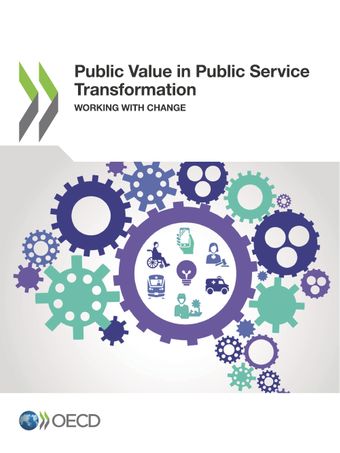Public Value in Public Service Transformation: Working with change

Overview
The rise of platform economies, new consumption patterns and innovative technologies are transforming both service delivery and people’s lives in general. Smart solutions are entering our everyday lives and digitalisation and datafication of everything is the norm. In political economy, short-term considerations seem to prevail, while long-term challenges with cascading effects (like climate change and demographic shifts) are already being felt. Governments around the world are facing an unprecedented transformation process, where systems that have worked and delivered results in prior decades are being questioned.
This requires governments to engage in ‘systems change’ in new ways. Indeed, governments need to think about the future in a way that simultaneously leaves options open and focuses on long-term reform priorities. This means moving from a tactical to a strategic approach to system change. Strategic systems thinking means engaging with the future in new ways, considering the input of citizens and understanding the impact of changing public values. With fundamental shifts in society’s expected behaviour, the notion of public value is evolving to encompass variables that are hard to codify (e.g. trust, inclusiveness transparency, legitimacy, effectiveness, privacy, accountability). Thus, a more nuanced way to articulate shifts in systems is to look at how the composition of public value transforms during systems change.
The report argues that the way in which public governance will change in the future, will depend on how public sector manages three interdependent aspects:
- envisioning and acting on a specific future (making the future actionable);
- leading the systemic change process with a public value-based approach (both in directing change, but also analysing the effects of innovative change from a value perspective); and
- how democratic the overall process is – i.e. how are citizens engaged in the decision making (collective understanding of what kind of future citizens aspire to and what values they hold dear).
Chapter 1 discusses how to think about the future in a changing urban context and how the recent ‘smart governance’ trend fits the narrative. Chapter 2 analyses the public value domain, outlining the need to frame problems differently and tackles how to use the language of value to do so. Chapter 3 addresses how to engage citizens in this new era. Different key components of the process are outlined, such as risk and uncertainty, participation, deliberation and sortation. By connecting these three topics, the report put forward a new framework for using systems approaches to foster systems change.
Chapter 4 presents an analysis of seven in-depth case studies from around the world that exemplify the nexus of future-public value-civic action from an empirical perspective. The cases cover (1) deliberative democracy practices; (2) user-driven tactical strategies to innovation; (3) co-producing welfare; (4) collaborative innovation across administrative boundaries; (5) comprehensive responses to the new needs of the aging population; (6) technology-led transformation processes regarding the Internet of Things; (7) and the circular economy.
This report uses practical examples to presents the various strategies that different levels of government, including city-level governments, are deploying to deal with how their various systems are transforming. In addition, increasingly sophisticated methods are emerging to involve citizens in public value debates about these changes. As such, governments have invested in developing processes to examine exceedingly complex problems by deepening conversations with citizens (citizens’ reference panels and citizens’ assemblies in Canada). This has created design-driven, fast-based iterative processes to respond to the changing demand from citizens (New Urban Mechanics in Boston) or built coalitions with the private sector to explore transformative change (City of Things project in Antwerp). In some cases, cities, regions and national governments have started to discuss the right scale and scope of change, such as the need to go beyond their own administrative boundaries to address evolving citizen needs (collaborative innovation at the level of the Region of Gothenburg). Other examples include the creation of new responses to new and contextual needs (Seoul 50+ policy) and changing the purpose of public entities, entirely via transformative technological change (Waternet’s role in the circular economy in Amsterdam). Furthermore, public sector is exploring peer-to-peer production and local resilience to complex issues (Hope Care System in Namyangju) going beyond their traditional remits to solve welfare blind spots and deal with long unresolved problems. In all cases, complex public value transformations are mapped out. The empirical analysis identifies the opportunities and challenges public sector must address when dealing with uncertain futures.
Through case studies and the following discussion, the report argues that governments are no longer in a position to define and impose systems change from the top down. Sometimes the uncertainty of the future only allows us to agree on the boundaries of public values we are interested in achieving and then adapting to emerging situations. To make these responses coherent in complex situations, values connected to change require collective definition and, as such, new methods to allow for meaningful citizen participation are needed.

Public Value in Public Service Transformation: Working with change
Published on 19 December 2019.
